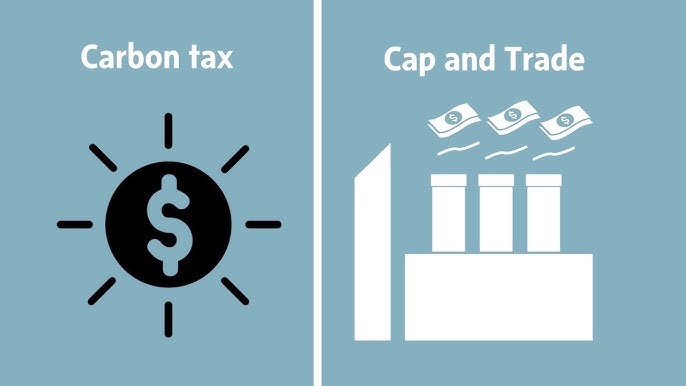Cap-and-trade and a carbon tax are two government policies created to reduce greenhouse gas emissions, and bring the country closer to its climate goals. A carbon tax directly puts a price on emissions, meaning that companies are charged a certain amount, depending on how much emissions they produce. On the other hand, the cap-and-trade program declares an emissions “allowance” each year. These allowances can be auctioned and traded from firms with excess allowances to big polluters, essentially creating a carbon price.
People in favor of the cap-and-trade program might say that it is truly the only policy that can guarantee an environmental impact, it has been working to protect the environment at lower costs, and it is politically attractive. Those supporting an overall carbon tax argue that it is a better approach because it is simple, minimizes government intervention, and avoids the creation of new markets and manipulation.
There are fundamental similarities between cap-and-trade and tax policies, but also important differences between them that must be taken into consideration to ensure that we reach our climate goals.
Key Similarities:
Both cap-and-trade and carbon taxes are able to correct an existing market failure. Sources responsible for the primary emissions must cover costs for the damages they impose on the climate. The failure to account for these costs leads to greater levels of emissions overall.
By placing a price on carbon, both approaches create an incentive to develop and invest in energy‐saving technologies. This will catalyze the shift to a lower carbon economy. Both policies also are forced to implement the lowest cost reductions in emissions due to market efficiencies.
A carbon tax is designed to raise revenue, but a cap‐and‐trade system, by auctioning allowances, can also raise similar amounts of revenue. However, the arguments as to how these revenues should be used becomes an important issue that has to then be addressed. Some proposals redirect the revenue directly back to consumers, others the revenues to ease the transition to a low carbon economy, and some combine both approaches.
By putting a price on carbon, both systems raise concerns about the impacts on energy‐intensive firms and manufacturing states, and on people that have always been dependent on fossil fuels. There would be a very large shift in wealth between sectors as a result of the transition from fossil fuels to clean energy.
Lastly, both solutions require consistent monitoring and verification. Both systems also require similar data on emissions, reporting and verification of that data, and the compliance of law enforcement.
Let’s get into the differences:
By setting a cap and issuing a certain amount of allowances, a cap‐ and‐trade system may be able to achieve a set environmental goal, but the cost of reaching that goal is entirely determined by market forces. In contrast, a tax provides complete certainty about the costs of implementation, but the resulting reductions in emissions are not predetermined and would also result from the market.
A carbon tax requires a firm each year to decide how much to reduce its emissions and how much tax to pay. Under a cap‐and‐trade system, borrowing and banking allows firms the flexibility to make compliance planning decisions on a multi‐year basis.
Additionally, changes in the state of the economy impact a firm’s behavior under both systems. Under a cap‐and‐trade system, lower economic growth would lower allowance prices. Under a tax, government policy would be required to address this. In times of positive economic growth, the opposite would be true. In this sense, cap-and-trade is pretty much a self‐adjusting price, depending on whether the economy is doing well or not.
As of now, the Obama administration has implemented a cap-and-trade system, but economists and policy makers have been shifting to favor a carbon tax. Either way, it is extremely evident that the environment needs help, and whether it is a carbon tax or cap-and-trade, immense structural change is needed to make that happen.

Comments are closed